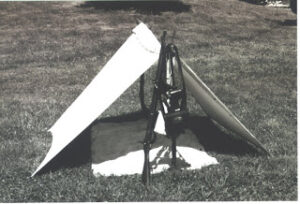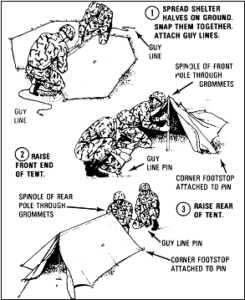Recent posts have mainly been about “the soldier’s load”. This blog is mainly about self-defence and preparedness so generally I try to keep things from getting too military. This has been a useful topic, however, since not only does it reveal solutions for civilian application but it also illustrates the differences between civilian and military applications. Today I will look at lightweight solutions to the need for shelter.
I recently saw an opinion that if a man who was bivouacking was surprised in the night he would take refuge in the dark of the forest. If a man in a tent was surprised, however, he would tend to take refuge behind the false security of his tent walls. Shelter for a soldier must consider tactical factors. Many of the tent designs a civilian might use are not suitable for military use unless required by a particular environment or situation.
A shelter can be thought of as a sort of sandwich. The uppermost layer is responsible for keeping off the rain, wind and sun. The middle layer keeps the sleeper warm. The bottom layer insulates the sleeper from damp ground and ground chill.

As an illustration of this let us consider how infantry in the American Civil War slept. Men would sleep in pairs, buttoning their shelter halves together to form a “dog tent”. Rifle-muskets might be used to support this structure. A gum-blanket was used as a ground cloth and each man slept wrapped in his woollen blanket. If the shelter cloth had been lost or discarded the top layer of the shelter would be created from the other man’s gum-blanket.

The basic soldier shelter has not changed that much since then. The ground sheet may now be plastic or a foam kipmat. The inner layer may be a sleeping bag or poncho liner rather than a blanket. A basha-sheet or poncho may be used instead of a cloth shelter half.
Unlike many civilian outdoorsmen the soldier is seldom alone. The makings of a shelter can be shared between a pair of men. For example, each man needs to carry only one support pole. As an aside, it is amusing how many kit lists I see that list the poncho as a shelter item yet do not include any support poles for the shelter. Perfectly positioned trees or ideal poles are not always to be found!
Suppose each soldier carries:
-
-
Poncho.
-
-
-
Support pole sections and pegs. Enough pegs to also secure a groundsheet. A screwdriver.
-
-
-
Lightweight sleeping bag with liner.
-
-
-
A ground cloth or kipmat.
-
Probably one man will sleep while the other stands watch. One of the ponchos creates the upper layer of the shelter. The other poncho can be worn by the man on watch if it rains. The other soldier sleeps in the lightweight sleeping bag and liner. If it is particularly cold he can use one sleeping bag within the other. Bulky “three or four season” sleeping bags are not necessary when it is warmer to use two lighter ones together. Giving each soldier his own sleeping bag liner makes sharing a sleeping bag a little more pleasant.
Beneath the sleeping soldier is the kipmat and a groundsheet. He may have placed found materials beneath the groundsheet to serve as a mattress. Kipmats can be trimmed to size to reduce weight and bulk.

A poncho has been chosen for the upper layer since it is the lightest and most versatile option. The poncho can be used as foul weather clothing as well as a shelter. On the downside the poncho is less robust than some of the other options. This is one of the reasons I do not suggest the poncho as a groundsheet.
The actual groundsheet could be an all-weather blanket but can be made from any piece of suitable waterproof material. It only needs to be large enough for one or two soldiers to sleep on so can be smaller than a poncho. In the past I have proposed a groundsheet with a brown side and a high visibility side so it can be also used for ground to air signals.
One man carries the kipmat, the other the groundsheet. A bivi-bag for use with the other items may also be carried by the man with the groundsheet. A pair of sandbags are carried for the eventuality that the sleeping man must keep his boots on. A hammock can be carried in environments where such might prove useful. Poncho liners or blankets may be added where the weather requires them.

The above system is designed with a measure of redundancy. The kipmat and groundsheet can be used on their own if one is lost. With only one poncho the bivi-bag still provides some protection, etc. Many of the proposed items can also be used as foul or cold weather clothing. This is why some of the recent posts have been on subjects such as cloaks.